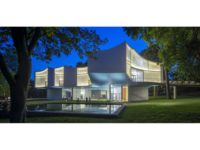Rocking the Walls
Using Natural Slate Siding








A new trend is emerging in commercial and residential construction. As architects and designers continue to migrate toward natural and eco-friendly products, real natural slate has recently hit the options list for exterior cladding. Slate shingles, a long time historic favorite for permanent roofing, are now being seen used as siding on homes and commercial structures around the country. This is not necessarily a brand new trend.
A trip to just about any European country, especially Germany, Spain and the ever so design conscious France, reveals that this is a trusted and trendy option that has been used for decades in some areas—and centuries in others. Natural slate is a metamorphic rock formed from ancient sea beds millions of years ago that is easily split into slabs and used for everything from pool tables, to blackboards, to roofs.
“We chose slate for cladding two buildings near each other in Chattanooga because its appearance, longevity, and cost. Slate is elegant, providing rich color, texture, and reflectivity. It glistens in certain types of light. It is tactile—I witness people touching it all the time—it is stone, it is enduring. It is economical for a masonry assembly, less than cut stone or brick. Detailing it is straightforward, resulting in an excellent building envelope,” said Craig Kronenberg on his designs for Enzo’s Market and Southern Surgical Medical Center. He is associated with Hefferlin+Kronenberg Architects PLLC, in Chattanooga, Tenn.
From a cost standpoint the prevailing initial reaction to the mention of natural slate is that it is very expensive and out of reach on normal projects. The installed cost of slate roofing can vary a great deal from $10 to $30 per square foot depending on color, size and design. However the cost of the slate itself is typically only $3.50 to $5 per square foot.
Since the installation design can vary significantly from commercial to residential and is based on how the system is to perform (i.e. underlayment materials, coatings, fastening systems, and drainage designs), costs can vary. On comparison, the costs included above are basic installation labor and cladding material only and doesn’t include the moisture barrier or various fastening systems.
This project was built in the 1980s on coastal Georgia. Cedar clapboard siding was removed, and breathable weather and an air barrier was applied to the existing plywood, sealing all the nail holes, joints and window junctions. Natural slate was nailed directly to the plywood with an air powered nail gun and stainless steel ring shank nails (warranted in coastal areas with salt air and potentially high winds).
Labor and materials from the raw plywood sheathing out equated to $7.75 per square foot or $17,300 for the entire makeover. Cooling costs were reduced by 35 percent. This product will never have to be resealed or painted. With truly zero maintenance, the slate will likely far outlast the wood frame structure it is on and eventually reclaimed for use on another project—a common occurrence in the slate roofing industry.
Daniel Grundhoefer, AIA, Principal Architect at Quina Grundhoefer Architects in Pensacola, Fla. specified slate siding for the St. Sylvester Catholic Church. “We wanted a look for the building that expressed permanence with a material that would have low or no-maintenance. Because we had just completed a slate roofing project, we knew the cost of slate roof shingles. When we compared it to brick veneer, it actually was less expensive. We were able to achieve a unique look with a color (green) that is typically not used on an exterior wall—at a cost that saved the church money. However, we had initial concerns due to the susceptible hurricanes and strong storms in our area. The church has now gone through 3 significant hurricanes since 1994 (Erin, Opal and Ivan) when the building was built and it has held up remarkably, except for a few lost shingles,” said Grundhoefer.
The installation process can vary a great deal depending on the design of the system and substrate. In Europe, it is common to see exposed hook fasteners similar to those used to install roofing in the same area. There are a multitude of proven techniques, each with its own benefits, costs, and potential drawbacks. Thusly, consideration does need to be taken as to how the system is expected to perform, i.e. breathable vs. air tight, drainable vs. sealed, etc.
The National Slate Association has some design details available in the NSA’s Slate Roofs: Design and Installation Manual at slateassociation.org. This manual is available in print and online. While it is mainly dedicated to roofing installations, there is a specific section on siding installation and much of the general information on available colors, sizes and design options are pertinent to both roofing and siding.
It is impossible to say how quickly and to what extent this trend may develop. Over the past few decades, dozens of new products have entered the market, becoming popular and then exiting the cladding scene just as quickly. While products such as brick, stucco, cement siding, natural stone have faded in trending use, wood has remained a mainstay in the construction industry.
If European trends are any indication of things to come in “the new world”—as it seems to have been over the last several centuries—it is likely to catch on. In the meantime, keep your eyes open for 200-million-year-old rocks hanging out on the side of old and new buildings, wherever you may be. It is a sight you are not likely to forget.
Looking for a reprint of this article?
From high-res PDFs to custom plaques, order your copy today!









